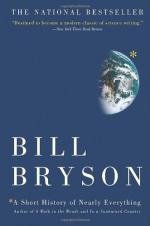|
This section contains 755 words (approx. 2 pages at 400 words per page) |

|
Part 1, Chapter 1 Summary and Analysis
Protons are so small that the dot in a printed letter i contains 5,000 million of them. The Big Bang, which is believed to be the origin of the universe, occurred when all existing matter was squeezed into a dot smaller than one proton. This space, so tiny it has no dimensions at all, is called a singularity. It's meaningless to discuss time and space in relation to singularities, for time didn't exist prior to the Big Bang, and neither did space.
In a single blinding pulse that lasted less than a minute, the universe expanded a million billion miles wide, and is still growing. Although there is some disagreement as to when this occurred, the general consensus among cosmologists is approximately 13.7 billion years ago. Georges Lemaitre, a Belgian priest, first proposed the Big Bang Theory in the 1920s, but...
(read more from the Part 1, Chapter 1 Summary)
|
This section contains 755 words (approx. 2 pages at 400 words per page) |

|




